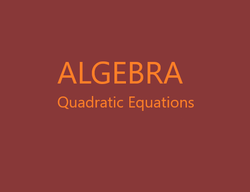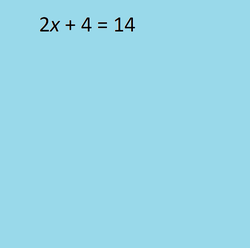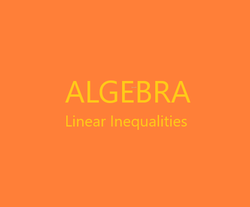A quadratic equation is an equation that can be put in the form of a second degree polynomial equal to zero. A second-degree polynomial has an x2 term, and possibly an x term, and perhaps a constant term, but no other appearances of the variable. Sometimes terms have to be moved from the side of the equation that will become zero by addition or subtraction. Sometimes symbols of grouping will need to be removed, a process often requiring the distribution of multiplication over addition. The distribution property is a(b + c) = ab + ac. And sometimes like terms, those to with the variable raised to the same power, will need to be combined.
A quadratic equation can have as many as two solutions. Some have only one solution, which is repeated. It is possible the solutions are complex numbers. If they are, the solutions are conjugates of each other, meaning if one is of the form a + bi the other is of the form a – bi.

















 The Linear Equation and Related Equations and Inequalitieson 08/15/2024
The Linear Equation and Related Equations and Inequalitieson 08/15/2024
 Understanding Calculus: A Simplified Approach to Derivativeson 08/05/2024
Understanding Calculus: A Simplified Approach to Derivativeson 08/05/2024
 Limits: Vital Building Blocks of Calculuson 08/01/2024
Limits: Vital Building Blocks of Calculuson 08/01/2024
 Mardi Gras Collectibleson 02/02/2023
Mardi Gras Collectibleson 02/02/2023



Comments
I prefer the use of matrices and the row reduction echilon technique, too advanced for the article but nice with a good graphing calculator. Completing the square gives the quadratic formula, and is the theory behind it, but completing the square also is used to find the center of a circle, or work with other conic sections of the the elllipse, hyperbola, and parabola, so we cannot ignore it, This is a difficulty in teaching, we know what is coming, but the student does not, so the student will often say I can ignore a concept and still solve every problem. A few weeks later it occurs to the student there was a reason the material was there.
blackspanielgallery, Thank you for the practicalities and products.
Which of the three methods do you prefer? Where does completing the square fit between the limited use of factoring (my favorite because the most fun, albeit not always the most applicable) and the workability of the quadratic formula despite the latter's not always making "the underlying idea clear"?